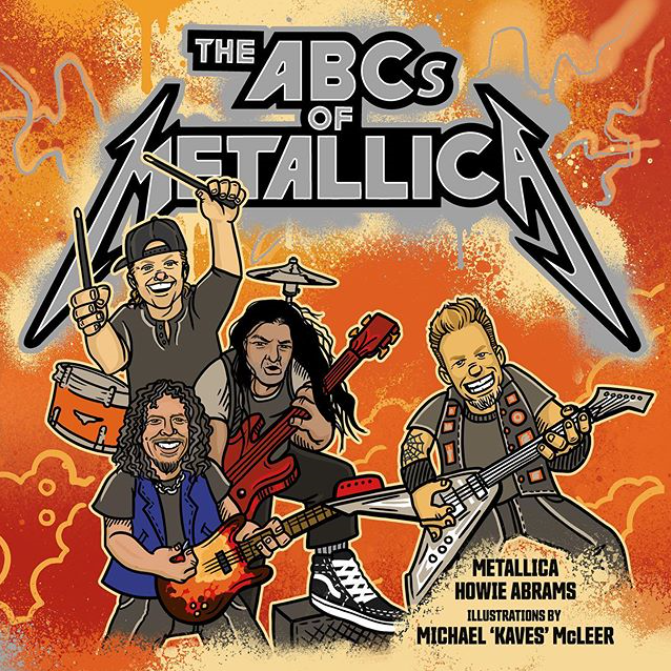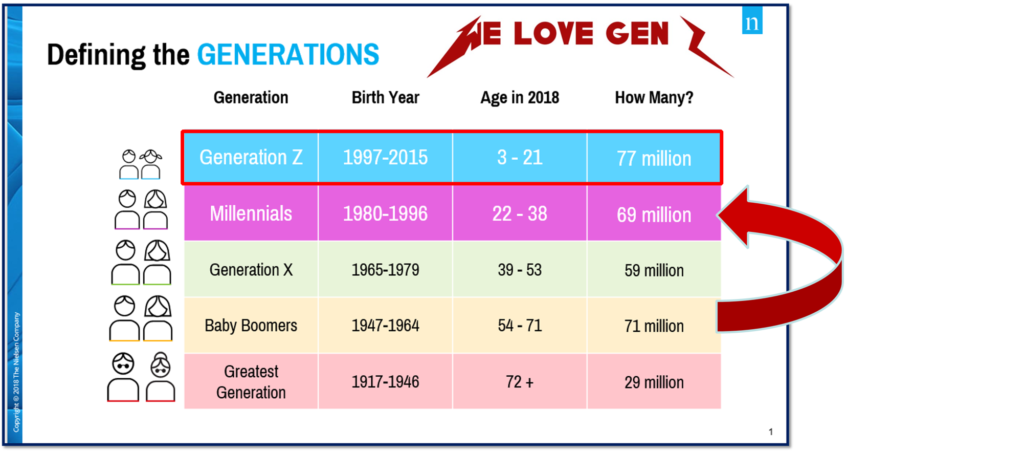
Brand extension may have reached an all-time low. That’s because Metallica has a new literary release coming out this Thanksgiving. It’s a children’s book called The ABC’s of Metallica.
That’s right – one of the badass metal bands of all time is readying a book for kids. Part of the proceeds will go to Metallica’s charitable foundation, All Within My Hands. The rest ostensibly will go right to the band’s bottom line – the definition of “non-traditional revenue.”
Two different versions of the story were sent to me by wife and a colleague. CNN and Spin each took the opportunity for a little friendly mockery of the band.
But aside from whatever altruistic motivation went into the decision to publish a children’s book, you have believe some smart marketer on Metallica’s team was looking at a chart like this one that Nielsen published a year or so ago:

Most people’s attention focuses on Millennials, now at essentially the same size as Baby Boomers. Of course, that’s a big deal.
But perhaps the bigger revelation is the size of Gen Z. Focusing at young people between 3-21 years of age, Nielsen says they are now 77 million people strong.
Metallica is most certainly going after the younger end of that demo – little kids whose parents read to them at night. Of course, Metallica hopes its adult fans who throw up devil horns when they hear “Master of Puppets” or “For Whom the Bell Tolls” will go to the band’s website to pre-order this kid’s book – perfect for bedtime stories.
I’m thinking that “S” will not be the page where the band tells the story about their less-than-stellar St. Anger album. Similarly, Spin wonders whether the “N”in the Metallica alphabet will stand for Napster, clearly another not-so-great chapter in the book. I’m wondering whether the “R” will, in fact, stand for Radio.
That’s because when it comes to appealing to Gen Z, broadcast radio needs all the help it can get. If you think about the many existential challenges facing radio over the next few years, there’s no question that “connected cars,” voice technology, and on-demand audio will be right up there.
But perhaps the one topic least often discussed in radio circles, company retreats, and conferences and conventions is the industry’s youth problem.  You don’t need national research studies to glean insight into what Gen Z kids are thinking. You just need to have a couple of “human Petri dishes” living in your home. Watching your kids use media and gadgetry will tell you all you need to know about how future generations of consumers will be occupying their time.
You don’t need national research studies to glean insight into what Gen Z kids are thinking. You just need to have a couple of “human Petri dishes” living in your home. Watching your kids use media and gadgetry will tell you all you need to know about how future generations of consumers will be occupying their time.
All this at a time when radio has been so myopically focused on 25-54 year-olds and even the “demographic cliff” that it has systemically and purposefully ignored teens and college students.
“If we can’t sell them, we don’t want them” has been the marketing mantra. And that’s why radio finds itself in an increasingly uncomfortable position today – a medium without a generational strategy.
Back in the ’90s when MTV was the only barrier to radio’s music monopoly, broadcasters could depend on kids of that era to come home to radio when they graduated from schools, bought cars, and joined the workforce. In other words, became like us.
But today, we’re living in a different world. Kids get their information and entertainment from different sources – Twitch, Instagram, YouTube, Spotify, Netflix, and other channels they can easily access on their mobile devices. Many simply don’t know what a radio is, nor is it necessary they do so.
So, while the media world may snicker at Metallica for focusing on adolescents (and their parents), Lars and company may get the last laugh. By acknowledging and nurturing the next generation of head bangers, Metallica is deploying some of their marketing resources to the future, even if most of the band may not be around to enjoy it. Maybe after looking at septuagenarians like Paul McCartney, Mick Jagger, Steven Tyler, and soon Bruce Springsteen, Metallica’s marketing team concluded there is potentially strong value in becoming a multi-generational brand.
So much of what kids learn is from moms and dads during those nighttime bedtime storytelling sessions. Many of us even remember some of those classic tales, all of which were read to us years and years ago.
Maybe the “S” stands for “Enter Sandman,” a song that vividly reminds us of those shadows in the bedrooms late at night.
Or maybe the “S” is short for smart, strategic, and savvy.
Sweet dreams.
- Can Radio Afford To Miss The Short Videos Boat? - April 22, 2025
- Media And Technology In 2025: Believe It Or Not! - April 18, 2025
- In Radio, You Just Never Know - April 17, 2025




Leave a Reply